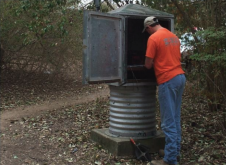Overview of Studies
The Aquifer Science Team evaluates groundwater drought conditions by continuously monitoring water levels and spring flow.
Previous studies have shown that with unmanaged pumping, current pumping rates and a recurrence of drought-of-record conditions could cause negative impacts to the groundwater resources within the District. The District developed a drought trigger methodology (DTM) in 2006. It has been modified since to improve declarations of drought and implement mandated conservation measures by groundwater users. These conservation measures are the primary means of protecting water levels and spring flow. The current DTM for the Edwards Aquifer is constantly being evaluated as new data is collected. In addition, a study devising a DTM for the Trinity Aquifer is anticipated in the near future.
Below is the District’s drought chart. The District’s drought status is determined by two factors: Barton Springs discharge (on the left) and Lovelady monitor well’s groundwater level (on the right). Once either determinant passes a drought threshold, the District is able to declare a new drought stage. To exit a drought stage though, both sites must rise above their respective drought threshold.

Relevant Publications
Highlighted below are a few publications related to drought status and trigger methodology. To view all of the District’s publications, click here.
Want to learn about additional studies?



